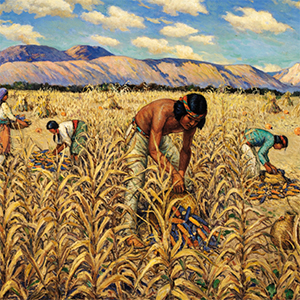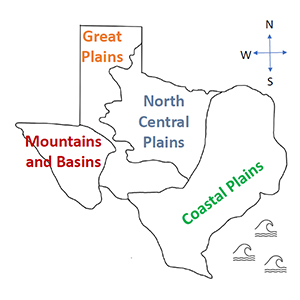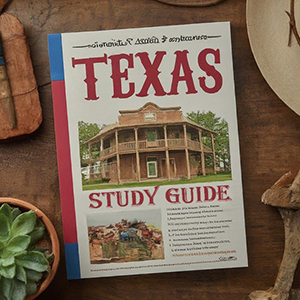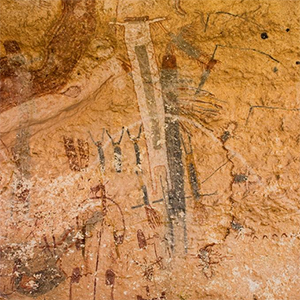Students will be able to write or speak a clear summary of the unit’s main ideas. They will be able to give at least one specific example of something that will be covered in the unit, especially one that relates to primary source materials.
THIS UNIT
Browse unit contents using the tabs to the right or the filters below.
Share
Tell other teachers, parents, and students about us.
Follow
Pacing
This unit is an eleven-day study of the regions and early Texas people before the arrival of the Spanish.
There are an optional 3 days of review activities and assignments to prepare students for testing. There is also an additional optional enrichment activity, “Voices of Texas History” providing a more in-depth look at rock paintings in south Texas as a form of recorded history.
Suggested pacing minutes are based on the average time it will take a class to complete each lesson; however, as the educator, use your best judgement based on the average pace of your class learning needs and styles.
Contents
Era Overview
In Natural Texas and its People (prehistory to 1528), students examine Texas’ geographic features and explore how the Native peoples in Texas interacted with the natural Texas environment before European colonization.
The geographic differences between the many regions that would come to be known as Texas were vast, stretching from the rich soils and lush vegetation of East Texas’ piney woods, to the swampier coastal plain along the Gulf of Mexico, to the drier and starker valley of South Texas, to the grasslands of the Texas central and high plains, to the arid and mountainous vistas of West Texas.
The first people of Texas were intimately connected to the physical geography of where they lived, with some groups prospering because of ample local resources while others struggled in challenging environments. Over many centuries, various native groups adapted themselves to all of Texas’ major geographic zones.
- The Caddo thrived in the fertile eastern piney woods, where they built large-scale villages and extensive trading networks.
- The Atakapa and Karankawa hunted, gathered, and fished in seasonal villages along the Texas coast.
- Various Coahuiltecan tribes often struggled in the more arid conditions of South Texas, while the Apache roamed the Plains on foot in search of bison.
- The Jumano in West Texas moved between established villages and hunting along the Plains, while the Wichita grew crops in the cross-timbers region that would become North Texas.
By the time the first Europeans arrived in Texas in 1528, each American Indian group had carefully adapted themselves to the particular regions in which they lived.
Unit Level Downloads (English)
-
Downloadable/Editable versions of the English language unit plan. Provides an Era Overview and pacing, and outlines each lesson’s estimated completion time, essential questions, a description of each lesson, and student learning experiences and activities.
Other Units
Lessons
Most lessons contain downloadable and printable documents, activities, and other resources to aid in classroom instruction. Lesson materials are available in multiple formats and typically contain variations based on learning needs.
The Big Picture
How do we know what we know?
Students will learn what primary and secondary sources are, as well as how to distinguish the difference between the two. Students will be able to give examples of each and explain the benefits and drawbacks of using primary sources when studying history.
Vocabulary
In this two-day lesson, students will be introduced to the key terms within the context of the unit through short reading passages. Students will be able to identify, define, and give examples in words and/or images of each key term in the unit.
What's the Story?
Students will read a passage that presents the various American Indian tribes of Texas within the context of pre-European exploration of Texas. They will be able to identify the significant information about various tribes, the power dynamics between certain tribes at the time, as well as which tribes were not yet present in Texas.
Texas Regions
In this two-day lesson, students will be able to identify, describe, and compare the distinct characteristics of each region of Texas.
American Indian Tribes of Texas
Students will study and be able to identify the distinct characteristics of the primary early American Indian tribes who lived in Texas prior to European exploration. Students will categorize information about each tribe into the categories: food, shelter, mobility, culture, and location in Texas.
Texas Today
Students will be able to identify key characteristics of Texas today related to natural and human geography. Students will be able to make connections between the human geography of Texas today and settlement patterns of early Texas people.
Looking Ahead
Students will be able to identify and summarize the primary characteristics of the era of Natural Texas and Its People. Students will also recognize the cause-and-effect relationship between the end of this era and the arrival of the Spanish. Students will predict what they might see in the next unit.
Bingo Review Game
In this optional, review lesson, students will play Bingo to review key terms and concepts within the unit by listening to clues to identify terms and concepts. Students will write brief summaries or key words related to each term.
Mind Mapping Review Lesson
Students will create a visual representation of the connections between terms and concepts from the unit in a mind map. Students will be able to visualize how information from the unit is connected by making connections between terms on a mind map.
Study Guide and Flashcards
In this optional review lesson, students will review key terms and information from the unit in preparation for the unit one assessment. Students will be able to identify, explain, and compare significant information from the unit.
Voices of Texas History Extension Lesson
Students will read a passage about the White Shaman Rock Shelter pictographs in South Texas. Students will be able to explain the significance and challenges of using pictographic artifacts in the study of history. This lesson will give students a chance to better understand how modern people make inferences about past people and to understand that historical assertions based on these early artifacts are not absolute.
American Indians in Texas Today Extension Lesson
Students will connect their knowledge of historical Texas tribes to the tribes of Texas today by researching one of the tribes provided on a brief list of both federally and non-federally recognized tribes. Students will be able to identify where the tribe is currently located, the government, history, and significant people of the tribe today. This activity could be used for extra credit, outside research, additional work for students who finish other work before the class, or an additional project.
Maps
We've assembled the following list of maps that are applicable to the Natural Texas & Its People Unit.
Secunda etas mundi
Map shows the pre-Columbus world, based on Ptolemy's Geographia. Jerusalem is at the center of the map; the Indian Ocean is an enclosed area; and Scandinavia, southern Africa and the Far East are not shown.
Heart of Texas West Wildlife Trail
Map of the heart of Texas West depicting birding trails, with related illustrations.
Far West Texas Wildlife Trail
Map of major highways in western Texas with markings for parks and wildlife preservation areas; it is surrounded by illustrations of animals found in the area. The back contains detailed text describing the locations marked on the map, organized regionally.
Ecoregions of Texas [Map]
Map color-coded to "denote areas of general similarity in ecosystems and in the type, quality and quantity of environmental resources" with a key to regions and sub-regions in the lower-left corner as well as a detailed explanation in the upper-right corner.
Vegetation Types of Texas
Map of Texas showing the vegetation types within the state and county lines. There is a color coordinated legend that shows the location in relation within the state.
Wildflowers of Texas
Map showing the wildflower regions of Texas. The front of the map is a collage of photos of various wildflowers and the back contains a map showing the regions and descriptions of the flower species.
Photo Relief Map of North America
This photo relief map shows North and Central America and the surrounding areas. Blue outlining marks countries, roads, and bodies of water. States, territories, and provinces throughout the continent are marked in dotted lines and labeled. Geographic features are marked with relief shown by spot heights and shading. A note in the lower left corner says, "Heights are given in Feet above Sea Level."
Videos
We provide videos for both continuing education and classroom use. Please see each video's descriptive page for related resources and details about accessibility and viewing options.
Preview of Natural Texas and its People
A short introductory video to the Natural Texas and its People Unit. Includes worksheets and/or other attachments.
Prehistoric to Spanish Explorers
Texas prehistory through Spanish exploration, covering: The Land and the Rivers, First Settlers before 1500, Indians of Texas by 1500.
More Resources
The following list of resources provide additional information to help you dive deeper into the context of the unit. Books are linked to OCLC WorldCat, allowing you find a copy in your nearest local library or to make a request for it using interlibrary loan.
General
website Results for Natural Texas & Its People in The Portal to Texas History
website The Handbook of Texas
book David La Vere, The Texas Indians (Texas A&M University Press, 2004).
book Daniel Gelo and Wayne Pate, Texas Indian Trails (Republic of Texas Press, 2003).














